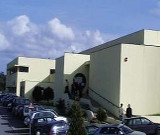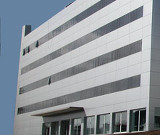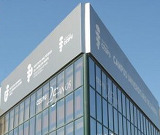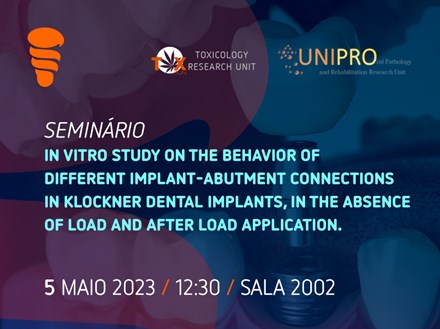2023 Seminar Series | Programa Doutoral em Ciências Biomédicas - 7ª. Edição
Data: 5 de maio
Hora: 12h30
Local de realização: Campus Universitário de Gandra - Sala 2002
ENTRADA LIVRE
TEMA:
“In vitro study on the behavior of different implant-abutment connections in Klockner dental implants, in the absence of load and after load application”.
Ana Sofia de Abreu Fernandes Vinhas, PhD (ORCID: 0000-0003-1444-000X)
UNIPRO-Oral Pathology and Rehabilitation Research Unit, University Institute of Health Sciences (IUCS), CESPU, 4585-116 Gandra, Portugal.
Anfitriã:
Marie Maziere, MSc
(DCB PhD student)
Resumo da apresentação:
Implant supported rehabilitations are an increasingly frequent practice to replace lost teeth. It would be desirable that prior to their clinical application, all implant components had to demonstrate suitable durability in laboratory studies. Fatigue tests utilizing cyclic loading typically simulate masticatory function in vitro. Purpose: evaluate the influence of implant- abutment connection design in torque maintenance after single tightening, multiple tightening and multiple tightening followed by mechanical cycling. Before and after mechanical demand it was also evaluated the integrity and wear of components, using SEM, and the axial displacement of the implant-abutment assembly, by Micro-Ct. Material and methods: 4 KLOCKNER implants (External connection-Sk2 and KL; and Internal Connection: VEGA and ESSENTIAL) were submitted to 3 different mechanical requests: single tightening (ST), multiple tightening (MT), multiple tightening and cyclic loading (500 N x 100 cycles) (MT+L). The removal torque values (RTV) of the screws were recorded after the 3 phases.16 samples were evaluated by SEM and Micro-CT (4 control samples; 4 Single tightening; 4 Multiple tightening; 4 Multiple tightening and cyclic loading). Surface topography and axial displacement of abutment into the implant from each group, was evaluated with SEM and Micro-CT and compared with an original sample. Results: After one single tightening, and for all connections, RTV were lower than those of insertion. After multiple tightening, RTV were significantly lower in all connections. After repeated tightening followed by cyclic loading, mean RTV were significantly lower, when compared to insertion torque, and this phase was the one that generated the lowest RTV, for all connections. The Vega implant obtained very similar mean values of removal torque in the 3 phases considered. In the state of manufacture, all the implants have revealed small structural alterations. The application of the tightening torque causes the appearance of contact marks on the faces of the hexagon of the abutment and the implant. These brands seem to increase in intensity and size with the increase in the number of assembly operations. The pillar-implant distances do not show statistically significant differences in the measurements made in SK2 and KL samples for any of the mechanical demand states analyzed. Statistically significant differences were observed in measure b in Vega implants. In Esential samples statistically significant differences in a and b measures were observed, between all mechanical demands. Conclusions: The connection design, in our study, influenced the maintenance of preload, under cyclic loading. Vega implants (internal connection) demonstrated a more consistent behavior, under the 3 mechanical demands. The multiple re-tightening technique resulted in higher removal torque values than the single tightening technique. Clinically, our results recommend to retighten retaining screws, a few minutes after insertion. The application of mechanical compression loads causes deformation and contact marks in all models tested. These marks increase in number and size with the increase in the number of mechanical compression loads applied. At a general level, a clear intrusion of the abutment into the implant can only be confirmed in the Essential model, which has obtained its maximum value under the conditions of cyclic loading.
Biography:
-Instituto Superior de Ciências da Saúde-Norte Gandra, Paredes, PT
1991-1997 | Licenciatura em Medicina Dentária
-Instituto Superior de Ciências de Saude: Gandra-Paredes, PT
2007-2010 | Mestrado em Periodontologia
-Colégio de Especialidade de Periodontologia da Ordem dos Médicos Dentistas
2016
-Universidad de Sevilla: Sevilla, ES
2019/09-2023/01 | Doutoramento em Patología Oral y Salud: Implicaciones locales y sistémicas (Departamento de Estomatología Facultad de Odontología de la Universidad de Sevilla)
-Instituto Universitário de Ciências da Saúde: Gandra, Porto, PT
1997-2023 |Professora no Serviço de Medicina e Cirurgia Oral
-Instituto Universitário de Ciências da Saúde: Gandra, Porto, PT
2018/01-2023 | Coordenação da Pós-graduação de Periodontologia e Peri-implantologia Clinica da CESPU








